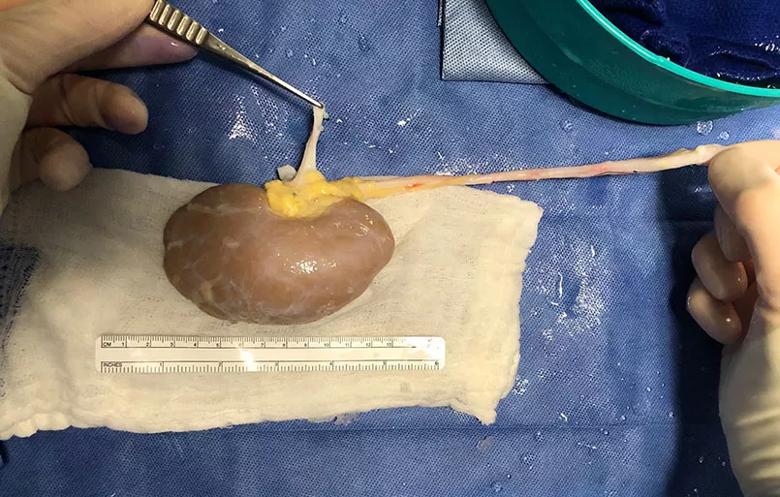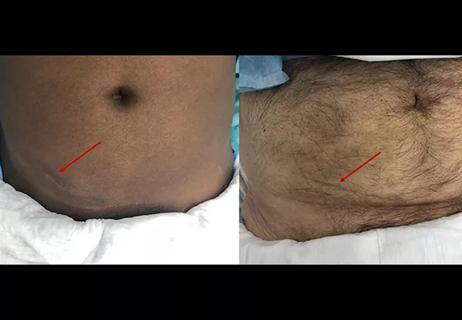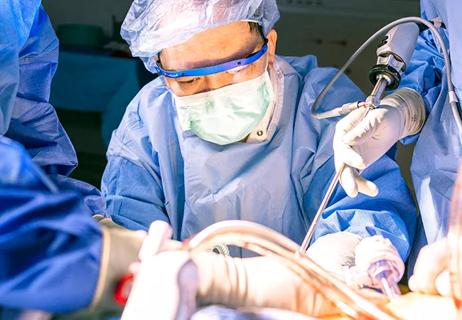Cleveland Clinic surgeons use single-incision robotic surgery to perform kidney transplant

Cleveland Clinic is the first hospital in the world to successfully perform a robotic single-port kidney transplant, which enables all surgical instruments and the donor kidney to be placed through one small abdominal incision.
Advertisement
Cleveland Clinic is a non-profit academic medical center. Advertising on our site helps support our mission. We do not endorse non-Cleveland Clinic products or services. Policy
The Glickman Urological & Kidney Institute surgical team included Jihad Kaouk, MD, director of the Center for Robotic and Image Guided Surgery; Alvin Wee, MD, surgical director of Renal Transplantation, Mohamed Eltemamy, MD, David Goldfarb, MD and Eric Miller, MD. These surgeons combined their collective expertise in minimally invasive, robotic and kidney transplant surgery to accomplish this first successful operation.
Dr. Kaouk and his team were the first in the country to successfully perform robotic single-port prostatectomy and kidney cancer surgery in September 2018. This new technique provides evidence that the single-port approach is feasible not only for patients with cancer, but also for patients who are in need of a kidney transplant.
“The aim was not only to make a smaller incision, but also to minimize the area in which the operation was performed by limiting the number of cuts inside the patient,” said Dr. Kaouk. “This resulted in minimal post-operative pain and no opioids needed after surgery.”
The robotic single-port platform may provide an alternative option for the appropriate patient, including patients with obesity or challenging anatomy. During the operation, the surgical team created a small four-centimeter incision below the patient’s belly button. The surgeon then used the single-port robot to prepare the site for the donor kidney, connect the blood vessels, and lastly reconstruct the urinary drainage, before suturing the incision.

The photo captures a kidney from the deceased organ donor. The blood vessels are stretched with a forceps and the ureter is stretched with the surgeons hand. This kidney was inserted through a small incision and attached to the patient to complete the transplant. The surgery was completed robotically, using the latest single-port robot.
Advertisement
“The robotic single-port approach is very promising,” said Dr. Wee. “We are looking forward to continuing to refine this technique and our team is optimistic that this minimally invasive surgery can add to our range of options for kidney transplantation.”
“Kidney transplantation continues to be the best treatment option for patients with end-stage kidney disease and it is a very dynamic field where innovation brings new opportunities for personalized care,” said Emilio Poggio, MD, medical director of the Kidney Transplant Program. “As such, this first robotic single-port kidney transplant adds cutting edge practice to the care of these patients.”
“Kidney transplantation is a life-changing event for patients, many of whose quality of life has been negatively impacted by having to receive dialysis three times a week while waiting for a donor,” said Georges Haber, M.D., chair of urology in the Glickman Urological and Kidney Institute. “This technique allows patients to regain their quality of life more rapidly.
Dr. Kaouk is a paid speaker for Intuitive Surgical, Inc.
Advertisement
Advertisement

Enhanced visualization and dexterity enable safer, more precise procedures and lead to better patient outcomes

Insights on bringing Cleveland Clinic even closer to becoming the best transplant enterprise in the world

Minimally invasive approach, peri- and postoperative protocols reduce risk and recovery time for these rare, magnanimous two-time donors

Minimally invasive pancreas-kidney replacement reduces patient’s pain, expedites recovery

First-ever procedure restores patient’s health

Smaller incision may lead to reduced postoperative pain for some patients

Improving access to lifesaving kidney transplant

The process could improve access for patients with end-stage kidney disease